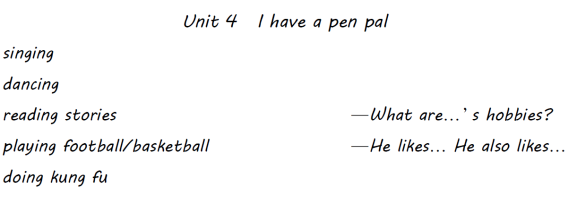人教pep六上英语 Unit 4 The second period第二课时教案
The second period(第二课时)
Part A Let’s learn & Do a survey
![]()
▶教学内容与目标
课时教学内容 | 课时教学目标 |
Let’s learn | ·能够听、说、读、写有关兴趣爱好的单词和词组:dancing, singing, reading stories, playing football, doing kung fu ·能够结合本部分核心句型“—What are your hobbies? —I like…”谈论兴趣爱好 |
Do a survey | ·能够根据调查结果完成表格,并根据表格信息做汇报 |
▶教学重点
1.掌握本课时的重点词汇和句型。
2.能够结合本部分核心句型“—What are your hobbies? —I like…”谈论兴趣爱好。
▶教学难点
能够结合本部分核心句型“—What are your hobbies? —I like…”谈论兴趣爱好。
▶教学准备
PPT课件、课文录音、视频等。
 ▶教学过程
▶教学过程
1
Step 1: Warm-up & Revision & Lead-in
1. Greetings. T: Good morning, boys and girls. Today I’ve prepared many colorful stars for you. If you behave well, you can get a star. The group which gets the most stars will be the super winner.
2. Let’s watch.
T:(课件出示:哆啦A梦的小视频) What can Doraemon do?
Ss:He can… (sing, dance, fly, swim, read…) (课件出示:哆啦A梦唱歌、跳舞、飞行、游泳、看书等的图片)
3. Lead-in.
T:Does Doraemon like singing?
Ss:Yes, he does.
T:How do you know that?
Ss:Because he looks very happy when singing.
T:Well done!
 Write down “sing—singing” on the blackboard. (课件出示:sing & singing的相关内容)
Write down “sing—singing” on the blackboard. (课件出示:sing & singing的相关内容)
Teach the words “sing” and “singing”. Ask students to pay attention to the “-ing” form.
Let students compare the following two statements:
①He can sing.②He likes singing.
Lead students to compare the meanings of the two words: “can” means something you are able to do; “like” means something you enjoy doing.
Step 2: Presentation
 1. Learn the word “dancing” and the phrase “reading stories”.
1. Learn the word “dancing” and the phrase “reading stories”.
T:Doraemon likes singing. He also likes…
Write down the sentence structures “He likes… He also likes…” on the blackboard. (课件出示:哆啦A梦唱歌、跳舞、飞行、游泳和看书的图片以及对应的动词)
Ss:He also likes dancing, flying, swimming and reading. (课件出示:动词后加上ing)
Write down the word “dancing” on the blackboard.
T:Look! What book is he reading?
Ss:It’s a storybook.
T:Yes. He likes reading stories. (课件出示:reading stories的相关内容)
Write down the phrase “reading stories” on the blackboard.
Teach the phrase “reading stories”. Extend the words “flying, swimming”.
 Present the original form of the verb and the “-ing” form, and lead students to understand the changes of the “-ing” form of different verbs through comparison.
Present the original form of the verb and the “-ing” form, and lead students to understand the changes of the “-ing” form of different verbs through comparison.
2. Learn the phrase “playing football”.
T I think Doraemon is a super star, because he can do so many things. Let’s find out what other hobbies Doraemon has. I’ll give you some clues.
(1)T:It is a ball. We can play the ball with our feet. So it’s a…
Ss: Football.
T:Wonderful! Look! He likes playing football.(课件出示:playing football的相关内容)
Teach the phrase “playing football”. And write it down on the blackboard.
(2)T:What about this ball? It’s a… (课件出示:篮球的图片)
Ss:Basketball.
T:Do you like playing basketball?
Ss:…
Write down the phrase “playing basketball” on the blackboard.

Then make a brief summary: play+球类运动.
3. Learn the phrase “doing kung fu”.
T:Now we’ve known so many Doraemon’s hobbies. There is another popular cartoon star. He likes doing kung fu. Who is he? (课件出示:功夫熊猫图片)
Ss:Kung Fu Panda.
T:Yes, you’re right. Kung Fu Panda likes doing kung fu. He is also a kung fu star.
Present the phrase “doing kung fu” and teach it. (课件出示:doing kung fu的相关内容)
 Write down the phrase “doing kung fu” on the blackboard.
Write down the phrase “doing kung fu” on the blackboard.
4. “Let’s learn”.
(1)T:Kung Fu Panda likes doing kung fu. Zhang Peng likes doing kung fu, too. How about his other hobbies? Listen to the dialogue. Let’s see what Zhang Peng’s hobbies are. (课件出示:教材P39 Let\'s learn板块的音频)
T:What are Zhang Peng’s hobbies?
Write down the sentence structure “What are…’s hobbies?” on the blackboard.
Ss:He likes reading stories. He also likes singing and doing kung fu.
(2) Students read after the recording and pay attention to the pronunciation and the intonation.
(3) Practice the dialogue in pairs.
(4) Read the dialogue in roles.
5. Learn the changing rules of “v-ing”.
Help students know the changing rules first. Then let them practice. (课件出示:动词-ing变化规则的相关内容)
Step 3: Practice
1. What’s missing?
Present the pictures of different hobbies. (课件出示:跳舞、唱歌、游泳、读故事书、踢足球、打篮球和练武术的图片)
(1) Students read the words and the phrases quickly.
(2) The teacher does the actions. Students say the words or the phrases.
(3) Play the game. Students say the missing picture.
2. Do you know their hobbies?
Present the pictures of some popular stars. (出示课件) Let students talk about their hobbies.
Yang Liping—dancing TFBOYS—singing Messi—playing football Jackie Chen—doing kung fu
Make a model with a student first. Then ask students to work in pairs like this:
A: What are his/her/their hobbies?
 B: He/She/They like(s)…
B: He/She/They like(s)…
Step 4: Consolidation & Extension
1. Talk about your hobbies.
T:What are your hobbies? Talk about the things you like doing in your free time. (补充说明:教师可根据学生的表达进而生成板书,适时拓展。例如:drawing, playing ping pong/chess…, playing the guitar/piano/erhu/…等其他有关兴趣爱好的单词或词组。)
2. Do a survey.
(1) Make a group of six students. Ask students to interview their classmates and then give a report. Add more information to the chart when it’s necessary.

Students can do a survey like this:
A: What are your hobbies?
B: I like singing and dancing.
C: I like…
…
Make a model first. Then ask students to work in groups and complete the chart.
(2) Show time.
Ask students to give reports according to the surveys. They can report like this:
…students like… …students like…
3. Summary.
Make a brief summary according to the blackboard design. Evaluate students’ group work and select the best group.
1
▶板书设计

▶作业设计
1. Recite the words and the phrases in “Let’s learn”.
2. Practice the key sentence structures.
▶教学反思
1.由哆啦A梦的视频引入,利用活泼可爱的卡通角色带领学生迅速复习熟知的动词,为导入和授新做铺垫。
2.教学活动循序渐进,层层递进,呈现和授新做到词不离句,创设具体的语言情境,让学生在语境中学习和掌握词汇。
3.呈现活动有设计感和层次感,能有效帮助学生提升英语核心素养。以学生为本,多启发、多引导学生思考,培养学生的自主学习能力。
4.对课文内容进行整合和调整,既基于课本知识,又不局限于课本形式。在兴趣爱好的话题基础上,拓展必要的相关单词和词组,丰富学生表达。
5.板书设计清晰明了,重点突出,起到了很好的辅助作用。![]()
▶Teaching Contents & Teaching Aims
Let’s learn
· Be able to listen, speak, read and write the words and the phrases of interests and hobbies “dancing, singing, reading stories, playing football, doing kung fu”.
·Be able to use the sentence structures “—What are your hobbies? —I like…” to talk about interests and hobbies.
Do a survey
·Be able to make a survey, complete the chart, and make a report.
▶Teaching Priorities
· Be able to understand and master the key words and sentence structures of this period.
· Be able to use the key sentence structures “—What are your hobbies? —I like…” to talk about interests and hobbies.
▶Teaching Difficulties
· Be able to use the key sentence structures “—What are your hobbies? —I like…” to talk about interests and hobbies.
▶Teaching Procedures
Teaching Stages | Teacher’ s Activities | Students Activities | Teaching Purposes |
Warm-up & Revision & Lead-in | 1. Greetings. Greet students. Divide them into several groups. | Greet the teacher. Acquire the evaluation rules of group work. | Stimulate students’ interest in learning with the cartoon character. By describing Doraemon’s free time activities, lead students to review the verbs to get prepared for the lead-in. |
2. Let’s watch. Play the cartoon and ask a question: What can Doraemon do? | Talk about the things Doraemon can do. | ||
3. Lead-in. Talk with students. Teach the words “sing” and “singing”. Lead students to compare the meanings of “can” and “like”. | Talk with the teacher. Learn the words “sing” and“singing”. Know the differences between “can” and “like” in meanings. | Lead in the topic of the lesson. Lead students to pay attention to the difference of the verb form in the expression of different sentence structures and understand the difference between “can do” and “like doing” in meanings through comparison. | |
Presentation | 1. Learn the word “dancing” and the phrase “reading stories”. | Learn the new word, phrase and the “-ing” form. | Lead students to master the new word and the phrase in the specific context. |
2. Learn the phrase “playing football”. Teach the phrase and extend other ball games. | Find out what other hobbies Doraemon has. Learn the new phrase and ways to express playing ball games. | Introduce the word through vivid word -formation. Enrich students’ expressions of interests and hobbies. |
(续表)
Teaching Stages | Teacher’ s Activities | Students’ Activities | Teaching Purposes |
Presentation | 3. Learn the phrase “doing kung fu”. Introduce Kung Fu Panda. Present the phrase “doing kung fu” and teach it. | Learn and read the phrase “doing kung fu”. | Help students understand and master the phrase “doing kung fu” by the introduction of Kung Fu Panda. |
4. “Let’s learn”. Lead students to understand and read the dialogue. Organize them to work in roles in pairs. | (1) Listen to the dialogue. (2) Read after the recording. (3) Practice the dialogue in pairs. (4) Read the dialogue in roles. | Check whether students can understand the dialogue of “Let’s learn” correctly through listening. Get students familiar with the key sentence structures through various ways of reading. Lead students to acquire the regulations of “-ing” form. Help them improve the accuracy of expression. | |
5. Learn the changing rules of “v-ing”. | Observe the words and learn the regulations of “-ing” form and then practice. | ||
Practice | 1. What’s missing? (1) Present the pictures of different hobbies. (2)Do the actions. (3)Lead students to play the game “What’s missing?” | (1) Look at the pictures and read the words and the phrases quickly. (2) Say the words or the phrases according to the teacher’s actions. (3) Say the missing picture. | Practice the target language through the various activities of “quick reading”, “mime and say” and “say the missing picture”. Practice the target language by talking about the interests and hobbies of some popular stars that students know and are interested in. |
2. Do you know their hobbies? Present the pictures of some popular stars. Let students talk about their hobbies. Make a model with a student. Then ask students to work in pairs. | Work in pairs. Talk about the hobbies of some popular stars. | ||
Consolidation & Extension | 1. Talk about your hobbies. | Talk about the things they like doing in their free time. | Consolidate and extend the related expressions of students’ interests and hobbies in the form of brainstorm and surveying. Improve students’ language using ability in the created context. |
2. Do a survey. Make each group of six students. Organize them to do the survey. Make a model first. Then ask students to work in groups and complete the chart. Ask them to give reports. | Work in groups. Interview their classmates and then give a report. And then show to the class. | ||
3. Summary. Make a brief summary and evaluate students’ group work and select the best group. | Have an overview of the class according to the blackboard design. | ||
Homework | 1. Recite the words and the phrases in “Let’s learn”. 2. Practice the key sentence structures. 3. Do the exercises. | ||
1
